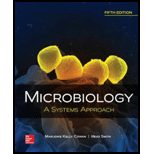
Microbiology: A Systems Approach
5th Edition
ISBN: 9781259706615
Author: Marjorie Kelly Cowan Professor
Publisher: McGraw-Hill Education
expand_more
expand_more
format_list_bulleted
Concept explainers
Question
Chapter 21.3, Problem 4AYP
Summary Introduction
To enlist:
Possible causative agents, modes of transmission, virulence factors, diagnostic techniques, and prevention and treatment of upper respiratory tract infections like common cold, sinusitis, otitis media, pharyngitis and diphtheria.
Concept introduction:
Diseases are caused due to the growth of various microorganisms inside the human body. They grow in the respiratory tract, nasal tract and alveoli of the lungs. Infection is caused by various strains of bacteria and viruses which penetrate the immune system of the host and proliferate with production of toxins inside the infected cells.
Expert Solution & Answer
Want to see the full answer?
Check out a sample textbook solution
Students have asked these similar questions
help tutor please
Q8. A researcher wants to study the effectiveness of a pill intended to reduce stomach heartburn in pregnant
women. The researcher chooses randomly 400 women to participate in this experiment for 9 months of their
pregnancy period. They all need to have the same diet. The researcher designs two groups of 200 participants:
One group take the real medication intended to reduce heartburn, while the other group take placebo
medication. In this study what are:
Independent variable:
Dependent variable:
Control variable:
Experimental group: "
Control group:
If the participants do not know who is consuming the real pills and who is consuming the sugar pills.
This study is
It happens that 40% of the participants do not find the treatment helpful and drop out after 6 months.
The researcher throws out the data from subjects that drop out. What type of bias is there in this study?
If the company who makes the medication funds this research, what type of bias might exist in this
research work?
How do I determine the inhertiance pattern from the pedigree diagram?
Chapter 21 Solutions
Microbiology: A Systems Approach
Ch. 21.1 - Prob. 1AYPCh. 21.1 - Prob. 2AYPCh. 21.2 - Prob. 3AYPCh. 21.3 - Prob. 4AYPCh. 21.3 - Prob. 5AYPCh. 21.3 - Prob. 6AYPCh. 21.4 - Prob. 7AYPCh. 21.4 - Prob. 8AYPCh. 21.4 - Prob. 9AYPCh. 21.4 - Prob. 10AYP
Ch. 21.4 - Plan a response for a situation in which a patient...Ch. 21.4 - Compare and contrast antigenic drift and antigenic...Ch. 21.5 - Prob. 13AYPCh. 21.5 - Prob. 14AYPCh. 21.5 - Prob. 15AYPCh. 21.5 - Prob. 16AYPCh. 21.5 - Prob. 17AYPCh. 21.5 - Prob. 18AYPCh. 21.5 - Prob. 19AYPCh. 21 - Prob. 1MCQCh. 21 - Prob. 2MCQCh. 21 - Which is not a characteristic of Streptococcus...Ch. 21 - The common stain used to identify Mycobacterium...Ch. 21 - Prob. 5MCQCh. 21 - Prob. 6MCQCh. 21 - Which of the following infections often has a...Ch. 21 - Prob. 8MCQCh. 21 - Prob. 9MCQCh. 21 - Prob. 10MCQCh. 21 - Prob. 11TFCh. 21 - Prob. 12TFCh. 21 - Prob. 13TFCh. 21 - Prob. 14TFCh. 21 - Prob. 15TFCh. 21 - Prob. 1CTQCh. 21 - Prob. 2CTQCh. 21 - Prob. 3CTQCh. 21 - In an episode of the television show House. Dr....Ch. 21 - Prob. 5CTQCh. 21 - Prob. 1VCCh. 21 - Prob. 1CM
Knowledge Booster
Learn more about
Need a deep-dive on the concept behind this application? Look no further. Learn more about this topic, biology and related others by exploring similar questions and additional content below.Similar questions
- 22. Which of the following mutant proteins is expected to have a dominant negative effect when over- expressed in normal cells? a. mutant PI3-kinase that lacks the SH2 domain but retains the kinase function b. mutant Grb2 protein that cannot bind to RTK c. mutant RTK that lacks the extracellular domain d. mutant PDK that has the PH domain but lost the kinase function e. all of the abovearrow_forwardWhat is the label ?arrow_forwardCan you described the image? Can you explain the question as well their answer and how to get to an answer to an problem like this?arrow_forward
- Describe the principle of homeostasis.arrow_forwardExplain how the hormones of the glands listed below travel around the body to target organs and tissues : Pituitary gland Hypothalamus Thyroid Parathyroid Adrenal Pineal Pancreas(islets of langerhans) Gonads (testes and ovaries) Placentaarrow_forwardWhat are the functions of the hormones produced in the glands listed below: Pituitary gland Hypothalamus Thyroid Parathyroid Adrenal Pineal Pancreas(islets of langerhans) Gonads (testes and ovaries) Placentaarrow_forward
arrow_back_ios
SEE MORE QUESTIONS
arrow_forward_ios
Recommended textbooks for you
- Basic Clinical Lab Competencies for Respiratory C...NursingISBN:9781285244662Author:WhitePublisher:CengageUnderstanding Health Insurance: A Guide to Billin...Health & NutritionISBN:9781337679480Author:GREENPublisher:Cengage
 Microbiology for Surgical Technologists (MindTap ...BiologyISBN:9781111306663Author:Margaret Rodriguez, Paul PricePublisher:Cengage Learning
Microbiology for Surgical Technologists (MindTap ...BiologyISBN:9781111306663Author:Margaret Rodriguez, Paul PricePublisher:Cengage Learning  Medical Terminology for Health Professions, Spira...Health & NutritionISBN:9781305634350Author:Ann Ehrlich, Carol L. Schroeder, Laura Ehrlich, Katrina A. SchroederPublisher:Cengage LearningHealth Safety And Nutrition F/Young ChildHealth & NutritionISBN:9781305144767Author:MAROTZPublisher:Cengage
Medical Terminology for Health Professions, Spira...Health & NutritionISBN:9781305634350Author:Ann Ehrlich, Carol L. Schroeder, Laura Ehrlich, Katrina A. SchroederPublisher:Cengage LearningHealth Safety And Nutrition F/Young ChildHealth & NutritionISBN:9781305144767Author:MAROTZPublisher:Cengage

Basic Clinical Lab Competencies for Respiratory C...
Nursing
ISBN:9781285244662
Author:White
Publisher:Cengage

Understanding Health Insurance: A Guide to Billin...
Health & Nutrition
ISBN:9781337679480
Author:GREEN
Publisher:Cengage

Microbiology for Surgical Technologists (MindTap ...
Biology
ISBN:9781111306663
Author:Margaret Rodriguez, Paul Price
Publisher:Cengage Learning


Medical Terminology for Health Professions, Spira...
Health & Nutrition
ISBN:9781305634350
Author:Ann Ehrlich, Carol L. Schroeder, Laura Ehrlich, Katrina A. Schroeder
Publisher:Cengage Learning

Health Safety And Nutrition F/Young Child
Health & Nutrition
ISBN:9781305144767
Author:MAROTZ
Publisher:Cengage